AUTOMATION AND CONTROL
A low-cost monitoring alternative for unconventional gas
Group metering doesn’t provide data necessary for optimizing production, but conventional SCADA is too expensive for low-production gas fields. A new, low-cost system uses acoustic monitoring to bring data from individual wells to the operator.
Steve Conquergood, Advanced Flow Technologies Inc.; and Lawrence Schafers, Pengrowth Corp.
Producers of unconventional gas fields are often forced to rely on group metering, since the cost of metering individual wells by conventional Supervisory Control And Data Acquisition (SCADA) cannot be justified for the lower production volumes in these fields. This can lead to higher operational costs and lower production, because operators do not have data from specific wells that would allow them to optimize service operations, minimize downtime and maximize production.
A low-cost monitoring solution has been developed specifically targeted at unconventional wells. Advanced Flow Technologies’ Flow-Net is a Web-based system that is easy to install and non-intrusive, using an acoustic sensor clamped to the outside of the pipe or wellhead. An optional pressure sensor can be added.
Pengrowth has applied the monitoring system to the North Twining coalbed methane (CBM) field. The system has been used to monitor new well production, optimize water removal, optimize gathering systems and enhance reporting above and beyond conventional spot-testing methods. Specific benefits have been seen in optimizing gas flow from the wells by balancing the pressures in the gathering system.
TECHNOLOGY
Some fundamental principles were established early in the development of the unconventional well-monitoring system:
- The system should be available at very low cost to target wells in unconventional gas fields, shallow gas and CBM operations
- Flowrate should be monitored with at least 90% accuracy
- The system should be completely non-intrusive; i.e., no parts in the pipe
- No downtime should be required for installation
- The system should be installable by the field operator without electricians or instrument technicians
- No pressure drop or flow restriction should occur in low-pressure systems
- The piping of the meter run should be eliminated to lower cost and allow installation on existing wellheads
- The system should be portable
- Data from the wellsites must be easily available for field staff
- The system must be self-powered, because no power is available at most sites.
Research indicated that no commercial system existed that could simply be improved or extended to satisfy all of these requirements, so a new approach to flow monitoring would be needed.
Early lab testing and field trials using acoustic flow monitoring showed some promising results, but at lower-productivity gas wells only very low levels of acoustic energy were seen, and this energy would need substantial amplification to develop a workable monitoring system. Two years of further R&D resulted in the successful development of both a sensor and electronics with sufficient amplification to monitor flow with low acoustic energy. This involved testing numerous mechanical assemblies, pipe attachment methods, microphone sensors, excitation circuits and software routines for filtering and spectral analysis. Further development of the sensor, along with data processing, Web-based communication and office systems, yielded a complete end-to-end monitoring system, Fig. 1.
 |
Fig. 1. The unconventional well-monitoring system from Advanced Flow Technologies incorporates an acoustic flow sensor with data processing, Web-based communication and office systems for a complete end-to-end monitoring system.
|
|
An advantage of the Web-based data display is that all staff members, including field operators and office personnel (production, facilities, projects, completions, reservoir specialists and other authorized users), have simultaneous access to the field data. This allows for very effective communications and quick problem resolution, based on objective measured data, not speculation. Data can be exported from the website either on demand for special analysis or as a continuous data feed into existing corporate systems.
The acoustic sensor includes mechanical elements that greatly amplify the acoustic energy from inside the pipe, a highly sensitive microphone for converting the amplified sound waves to electrical energy, electrical cable connections, filtering elements to minimize unwanted ambient site sounds and a clamp for easy attachment to the pipe, Fig. 2. All elements are fully waterproof and rated to operate from -40 to 60°C (-40-140°F). The sensor uses only about .002 W of electrical power from the battery.
 |
Fig. 2. The acoustic sensor clamps to the outside of the pipe or wellhead, so it is easy to install and does not disrupt flow.
|
|
The other main component of the on-site system is the electronics enclosure, Fig. 3. The system is intended for installation primarily at sites that have no electric power, so it includes a 12-V DC primary battery and a solar panel for recharging the battery. The battery will provide 20 days of life for the system at -30°C (-22°F) with zero solar power input. Experience in the Canadian north during full winter service on a gas pipeline near the Yukon Territory has shown the system to be reliable and robust.
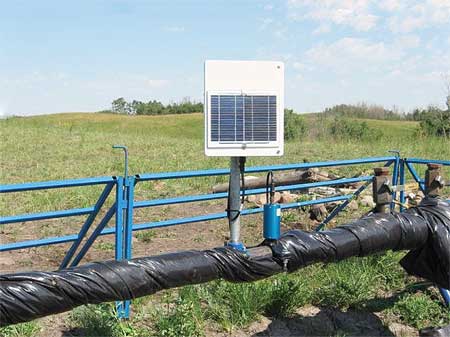 |
Fig. 3. The on-site system’s electronics enclosure encompasses 12-V DC primary battery power and a solar panel for recharging the battery.
|
|
The electronics for measuring the acoustic inputs, signal processing, data logging, communication and operator interface were developed by Advanced Flow Technologies to suit the company’s specific application requirements. An acoustic measurement is taken once per minute; 60 of these 1-min. readings are averaged to obtain an hourly reading, which is then reported to the user. The system also logs individual 1-min. point readings for 8 days for a higher-resolution download if desired.
The data is sent via satellite modem, using an antenna mounted inside the enclosure to minimize size, cabling and possible damage. The current shipping software version allows for transmission once, twice or four times per day, although additional options are under development. Both radio and cellular phone transmission were considered during product design, but both of these alternatives require more cost for infrastructure, such as antennas and towers, even though they offer higher data bandwidth than the satellite alternative selected. The selected system also has the advantage of global coverage with a single device and service provider, whereas radio and cell phone systems are more localized. For systems with higher reporting requirements, and consequently higher bandwidth requirements, the monitoring system can be adapted easily for alternative modems and communication modes.
In response to customer requests, Advanced Flow Technologies added an optional static pressure transducer in 2006. The pressure data is displayed on the website as a green signal trace together with the flow data, Fig. 4. The display allows very easy troubleshooting of problem locations, because the user can easily determine if reductions in flow are being caused upstream or downstream of the installation location based on the relationship between flow and pressure; a direct relationship indicates an upstream restriction and an inverse relationship indicates that the restriction is downstream.
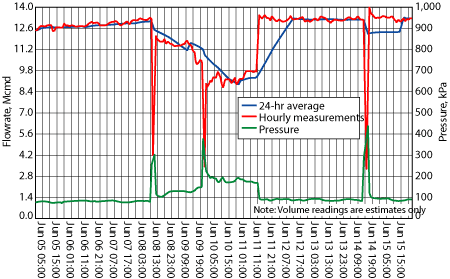 |
Fig. 4. Data from the optional pressure sensor is displayed as a green signal trace. An inverse relationship between pressure and flow, as shown here, indicates a restriction downstream of the sensor.
|
|
The company’s primary objective for the technology—low enough cost to be targeted at unconventional gas fields, shallow gas and CBM operations-has also been met; the monitoring system has a list price of C$2,200, with an additional C$750 for the pressure sensor. Data transmission, website hosting and reporting for an unlimited number of company users varies from C$25 to C$40/mo, depending whether one, two or four daily transmissions are made. This compares very favorably with pricing for conventional SCADA or measurement solutions, which range from “low cost” alternatives in the range of C$6,000-C$10,000, installed cost, to systems with more capabilities ranging up to C$20,000. These options tend to provide higher accuracy and more features, but are often prohibitively expensive for unconventional gas fields.
TYPICAL USES
Unconventional gas producers are using the new monitoring system in a variety of ways to optimize field performance. The examples below are indicative of some of the main application areas.
Service interval optimization. One of the most common operational problems in unconventional gas fields is the necessity of removing water from the wellbore. Many unconventional gas wells use large-bore open casing or large-diameter production tubing to minimize pressure drop when flowing from low-pressure reservoirs, but this practice can result in insufficient flow velocity to carry any produced water to surface. A wide variety of techniques are used to remove this water from the wellbore, including continuous mechanical systems, such as plunger lift and pumps, and intermittent systems, such as switching valves, soap injection, swabbing and blowing out the water with high-pressure air. All of these techniques involve some operational cost, so it is important to optimize the timing of these interventions, especially with low-productivity wells. Unfortunately, without remote wellhead monitoring, the operator must either drive to the well to determine the need for service, rely on historic average well performance, or even resort to field-wide averages and perform service treatments on every well at the same time.
Optimizing the timing interval for water removal is critical in many cases, but evaluating other service activities is also important. In many cases, service activities are performed on a “blanket” or field-wide basis, because no individual well data is available.
Figure 5 shows production over time for a well that experiences regular declines in production, which are mitigated using various well-service activities. This data allows the producer to evaluate the cost-effectiveness of various treatments, and also to optimize the service interval for maximum production.
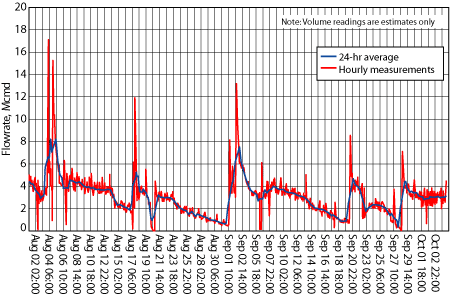 |
Fig. 5. Monitoring how effectively regular declines in production are mitigated using various well-service activities allows the producer to evaluate the cost-effectiveness of various treatments, and also to optimize the service interval for maximum production.
|
|
Comparing new well performance. Most unconventional gas fields include some level of new drilling and capacity expansion over time. Monitoring systems installed at the wellhead allow specific evaluations to be made of drilling and completion techniques, reservoir characteristics, and capital program results.
In a case where two wells were drilled in the same section and were brought onstream the same day, a bump in production seen on a downstream group meter would suggest that both wells were producing and contributing to the increase. Individual wellhead monitoring lets the operator know if in fact all of the production increase is coming from only one of the wells, Fig. 6. In such a case, investigating and solving the problem at the second well may yield significantly increased production. Without individual monitoring, the need for such intervention would have gone unnoticed.
 |
Fig. 6. Individual well monitoring allows the user to tell if two new wells brought onstream at the same time are both producing, or if one may require intervention. Group monitoring would only indicate overall production.
|
|
Recompletions. In addition to new well productivity, the system is used to monitor the effectiveness of recompletion techniques in unconventional gas wells. A wide variety of materials, techniques, processes and contractors are used to increase production rates, and the system provides an objective method of evaluating each activity’s effectiveness.
For example, in a section of one unconventional gas field, two wells were fractured on the same day, using the same techniques and materials. The 24-hr production test for one well reported flow of 320 Mcfd (9 Mcmd), while the second well reported 490 Mcfd (14 Mcmd). Based on this data, the project, reservoir engineering, production and facilities staffs would all operate based on an assumption that the second well was performing better, until the next spot-testing interval arrived and updated data was available.
However, continuous monitoring shows that, in fact, production in the second well was initially stronger, but then declined much more quickly, so the first well actually contributed more production over a prolonged period, Fig. 7. This conclusion has implications both for short-term operations and facilities and for long-term plans, such as future projects and reserves allocation.
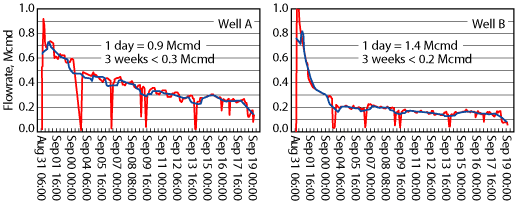 |
Fig. 7. A spot test for these two unconventional gas wells, fractured on the same day, showed greater flow in well B. However, the new system’s continuous monitoring showed that, in fact, production in well B was initially stronger, but then declined much more quickly, so well A actually contributed more production over time.
|
|
CBM APPLICATION
Pengrowth Corp. installed 25 of the monitors on unconventional gas wells at North Twining field in central Alberta starting in 2006. North Twining is a newly developed CBM field producing from the Horseshoe Canyon coal formation of the Edmonton group. At the outset of development, it was determined that some form of individual well monitoring would be beneficial. Perceived benefits included swifter intervention by operations and production engineering staff during periods of reduced or lost production, better data for analysis of drilling and completion techniques, improved reservoir characterization and more effective use of operations resources.
The technology was selected on a trial basis. Effective monitoring of well performance could also have been accomplished using conventional metering with SCADA. A number of other monitoring alternatives were considered, including dry flowmeters and electronic flowmeters. These options offered the advantage of established technology and higher accuracy, but they required some form of internal restriction in the pipe. This would have caused some pressure drop, which can severely restrict production on very low-pressure CBM wells, as well as creating a risk of freeze-up due to water accumulation. Pengrowth decided to install Advanced Flow Technologies’ monitoring system rather than conventional meters after comparing the additional capital cost vs. benefit of increased flow-measurement accuracy. With some variation depending on the technology considered, this cost-benefit analysis showed that the installed cost of conventional metering with SCADA would be about 3-7 times that of the new system. Monthly data transmission costs for conventional metering range from the same to three times the cost of the new method. In the case of unconventional gas characterized by low, stable production rates, previous experience has demonstrated that group metering provides suitable levels of accuracy. Operators have found that in most cases they can meet the regulatory requirement that proration factors from spot testing agree with group meter results within 85% accuracy. The benefit of individual well monitoring for operations purposes was still desirable, but the capital cost of traditional systems was not justified.
RESULTS
The following examples illustrate some of the ways in which Pengrowth made use of the low-cost individual well monitoring system to optimize its operations in North Twining field.
Field optimization. The system allowed Pengrowth to track the specific flow and pressure responses of individual CBM wells as new production was introduced throughout the field, rather than just monitoring overall production through group metering. This allowed the operator to adjust production from individual wells in order to optimize full-field performance.
On Aug. 2, 2007, six new CBM wells were added to the field, resulting in a noticeable drop in flowrate and an increase in wellhead pressure at well 9-19-32-24. On Aug. 8, another new well was added, this one producing from a high-permeability sand deposit, and the performance at 9-19-32-24 was once again reduced, Fig. 8. By measuring the production at individual wells during this period, the operator was able to find the optimum strategy to balance the entire field. The decision was made to restrict new production from the new, high-permeability sand well, to restore production at 9-19-32-24 and thereby enhance total field performance.
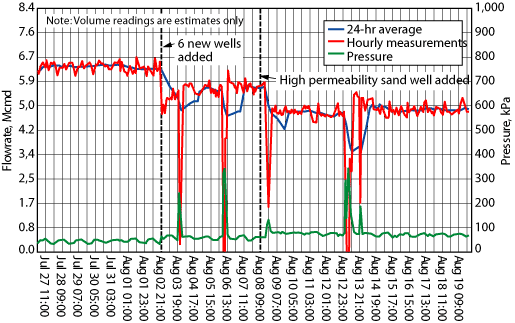 |
Fig. 8. Wellhead changes at North Twining well 9-19-32-24 are shown as new field production is brought online. By measuring the production at this individual well, the operator was able to find the optimum strategy to balance the entire field.
|
|
Response to facilities and reservoir changes. Optimizing the field gathering system to achieve low wellhead pressure is a major objective for CBM operations. Typically, because SCADA systems are cost-prohibitive, the only wellhead pressure data that is available is intermittent measurements obtained by operators driving to the well and then manually reporting the pressure readings. This is a very expensive method of collecting data. In addition, it is prone to errors as data is transcribed from system to system, and it still does not provide data trending over time, which would show the effects of facilities and reservoir changes.
On July 22, 2007, a downstream compressor was shut in at North Twining field, causing production at well 7-10-33-26 to quickly drop to zero. After the compressor came back online on July 30, the well immediately returned to its previous level of production, Fig. 9. Though this compressor shut-in was planned, the example illustrates the ability of the well-monitoring system to act as an “alarm” when downstream facilities go offline or changes occur in the reservoir unexpectedly. The system can also show whether production was fully restored after a reservoir or facilities change is addressed.
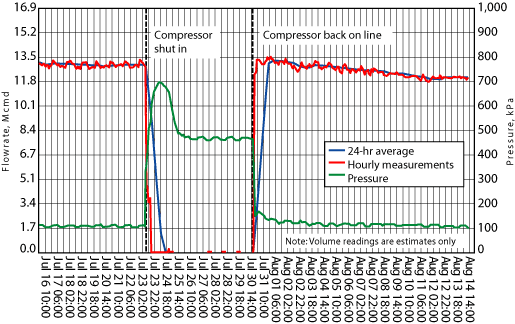 |
Fig. 9. Displayed wellhead changes at North Twining well 7-10-33-26 during compressor shut-in illustrate the system’s ability to act as an “alarm” when downstream facilities go offline or changes occur in the reservoir unexpectedly.
|
|
Cost-effectiveness of wellbore water removal. Well 14-30-32-24 had water cleaned out on July 3, 2007, resulting in a sudden and dramatic increase in production, to an average of 148.3 Mcfd (4.20 Mcmd) from 55.8 Mcfd (1.58 Mcmd). However the increased production lasted only for 10 days, as the well again filled with water, Fig. 10. Based on the flowrate data for the individual well, the operator was able to measure the cost of dewatering the wellbore again against the expected production benefit. As of press time, the operator has not taken action to remove the water from well 14-30-32-24.
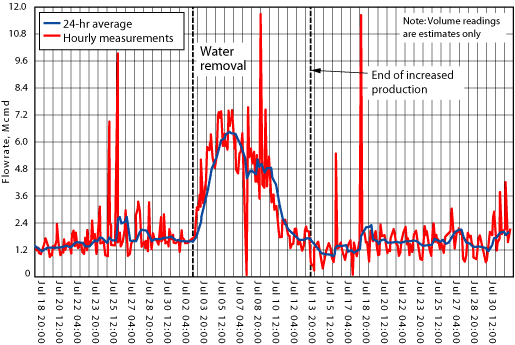 |
Fig. 10. By monitoring production at North Twining well 14-30-32-24 after water was cleaned out of the well, the operator determined that the probable increase from dewatering the well again did not justify the expenditure.
|
|
CONCLUSION
The new, low-cost monitoring method for unconventional wells has shown itself to be effective in monitoring wells on a regular basis, and Pengrowth has placed orders for additional systems. Operations personnel plan their daily route after reviewing flowrates, reducing the time spent on site and consequently reducing staffing requirements. Production engineers use the data to plan well cleanouts and monitor performance after intervention. Downtime from such events as a wellbore loading with water can be investigated in a timely fashion, which is especially significant in cases where the wells are operated by third parties. New well performance is closely monitored, and decline analysis is used to plan future development and infrastructure. The individual well monitoring is also beneficial for balancing the gathering system operation when new wells are added from high-permeability sand reservoirs.
The monitoring system has been used by producers in unconventional gas fields to complement their existing (high-accuracy) group metering with cost-effective, field-wide monitoring, so they can see the production from individual wellheads. This wellhead monitoring allows them to optimize service operations, minimize downtime and maximize production volumes. 
|
THE AUTHORS
|
|
Steve Conquergood is the chief technical officer of Advanced Flow Technologies and the inventor of the Flow-Net well-monitoring system. Mr. Conquergood’s diverse career includes project management, product design and development, and quality management. He has a mechanical engineering degree and 25 years’ experience specializing in measurement, automation, software and instrumentation.
|
|
| |
Lawrence Schafers is team lead from Project Engineering at Pengrowth Corp. He is also responsible for pipeline and facility construction related to the company’s coalbed methane program. Mr. Schafers has 15 years’ experience in project engineering and project management. He earned a BSc degree in mechanical engineering at the University of Alberta in 1992.
|
|
|












